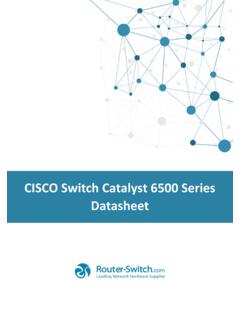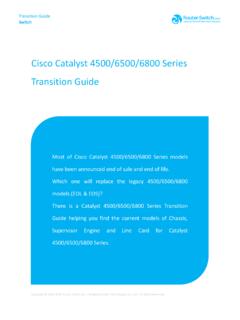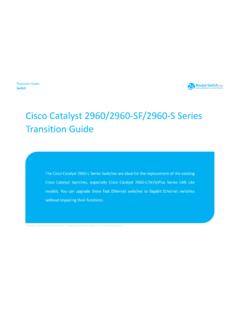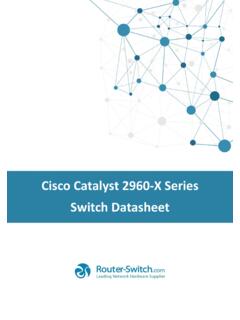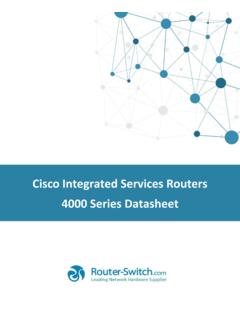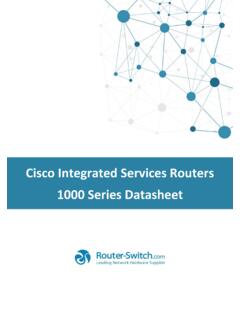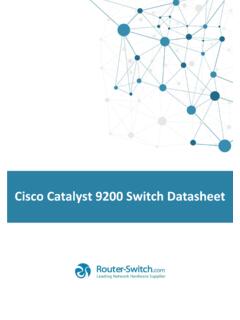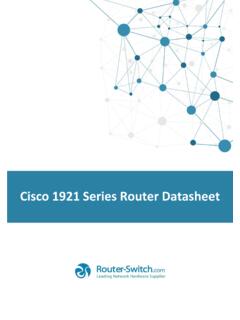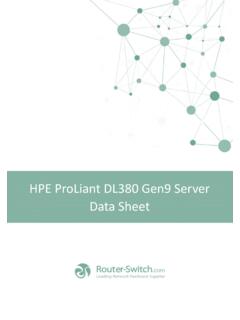Transcription of HPE 5130 EI Switch Series data sheet
1 Key features Fixed 10 GbE ports for high-speed stacking or uplinks Support for multiple services Comprehensive security control policies Diversified quality of service (QoS) policies Excellent manageabilityProduct overviewThe HPE FlexNetwork 5130 EI Switch Series comprises Gigabit Ethernet switches that support static and RIP Layer 3 routing, diversified services, and IPv6 forwarding, as well as provides four 10-Gigabit Ethernet (10 GbE) interfaces. Unique Intelligent Resilient Fabric (IRF) technology creates a virtual fabric by managing several switches as one logical device, which increases network resilience, performance, and availability, while reducing operational complexity. These switches provide Gigabit Ethernet access and can be used at the edge of a network or to connect server clusters in small data centers.
2 High availability, simplified management, and comprehensive security control policies are among the key features that distinguish this and benefitsSoftware-defined networking OpenFlowSupports OpenFlow specification to enable SDN by allowing separation of the data (packet forwarding) and control (routing decision) pathsQuality of service (QoS) Broadcast controlAllows limitation of broadcast traffic rate to cut down on unwanted network broadcast traffic Advanced classifier-based QoSClassifies traffic using multiple match criteria based on Layer 2, 3, and 4 information; applies QoS policies such as setting priority level and rate limit to selected traffic on a port, VLAN, or whole switchHPE FlexNetwork 5130 EI Switch SeriesData sheetPage 2 Data sheet Powerful QoS featureSupports the following congestion actions.
3 Strict priority (SP) queuing, weighted round robin (WRR), and SP+WRR Traffic policingSupports Committed Access Rate (CAR) and line rateManagement Remote configuration and managementEnables configuration and management through a secure Web browser or a CLI located on a remote device Manager and operator privilege levelsProvides read-only (operator) and read or write (manager) access on CLI and Web browser management interfaces Command authorizationLeverages HWTACACS to link a custom list of CLI commands to an individual network administrator s login; also provides an audit trail Secure Web GUIP rovides a secure, easy-to-use graphical interface for configuring the module via HTTPS Multiple configuration filesStores easily to the flash image Complete session loggingProvides detailed information for problem identification and resolution Remote monitoring (RMON)Uses standard SNMP to monitor essential network functions; supports events, alarm, history, and statistics group plus a private alarm extension group IEEE Link Layer Discovery Protocol (LLDP)Advertises and receives management information from adjacent devices on a network, facilitating easy mapping by network management applications sFlow (RFC 3176)Provides scalable ASIC-based wire-speed network monitoring and accounting with no impact on network performance.
4 This allows network operators to gather a variety of sophisticated network statistics and information for capacity planning and real-time network monitoring purposes Management VLANS egments traffic to and from management interfaces, including CLI/Telnet, a Web browser interface, and SNMP Remote intelligent mirroringMirrors ingress/egress ACL-selected traffic from a Switch port or VLAN to a local or remote Switch port anywhere on the network Device Link Detection Protocol (DLDP)Monitors a cable between two compatible switches and shuts down the ports on both ends if the cable is broken, which prevents network problems such as loops IPv6 managementProvides future-proof networking because the Switch is capable of being managed whether the attached network is running IPv4 or IPv6; supports pingv6, tracertv6, Telnetv6, TFTPv6, DNSv6, syslogv6, FTPv6, SNMPv6, DHCPv6, and RADIUS for IPv6 Page 3 Data sheet TroubleshootingIngress and egress port monitoring enables network problem-solving; virtual cable tests provide visibility into cable problems HPE Intelligent Management Center (IMC)Integrates fault management, element configuration, and network monitoring from a central vantage point; built-in support for third-party devices enables network administrators to centrally manage all network elements with a variety of automated tasks, including discovery, categorization, baseline configurations, and software images.
5 The software also provides configuration comparison tools, version tracking, change alerts, and more Network managementOffers SNMP v1/v2c/v3, with MIB-II Traps, and RADIUS Authentication Client MIB (RFC 2618); embedded HTML management tool with secure accessConnectivity Auto-MDIXA djusts automatically for straight-through or crossover cables on all 10/100/1000 ports Flow controlProvides back pressure using standard IEEE , reducing congestion in heavy traffic situations High-density connectivityProvides up to 48 fixed 10/100/1000 BASE-T ports in a Layer 2/Layer 3 Switch IEEE Power over Ethernet (PoE+) supportSimplifies deployment and dramatically reduces installation costs by helping to eliminate the time and cost involved in supplying local power at each access point location Ethernet operations, administration, and maintenance (OAM)Detects data link layer problems that occurred in the last mile using the IEEE OAM standard.
6 Monitors the status of the link between two devicesPerformance Non-blocking architectureUp to 176 Gbps non-blocking switching fabric provides wire-speed switching with up to million pps throughput Hardware-based wire-speed access control lists (ACLs)Helps provide high levels of security and ease of administration without impacting network performance with a feature-rich TCAM-based ACL implementationResiliency and high availability Separate data and control pathsSeparates control from services and keeps service processing isolated; increases security and performance External redundant power supply Provides high reliability Smart LinkAllows under 100 ms failover between links Spanning Tree/PVST+, MSTP, RSTPP rovides redundant links while preventing network loops, supports up to 64 instances of MSTPPage 4 Data sheet Intelligent Resilient Fabric (IRF)Creates virtual resilient switching fabrics, where two to nine switches perform as a single L2 Switch and L3 router; switches do not have to be co-located and can be part of a disaster-recovery system; servers or switches can be attached using standard LACP for automatic load balancing and high availability.
7 Can reduce need for complex protocols like Spanning Tree Protocol, Equal-Cost Multipath (ECMP), or VRRP, thereby simplifying network operationLayer 2 switching 16K MAC address tableProvides access to many Layer 2 devices VLAN support and taggingSupports IEEE with 4,094 simultaneous VLAN IDs IEEE QinQ and selective QinQIncreases the scalability of an Ethernet network by providing a hierarchical structure; connects multiple LANs on a high-speed campus or metro network 10 GbE port aggregationAllows grouping of ports to increase overall data throughput to a remote device Device Link Detection Protocol (DLDP)Monitors link connectivity and shuts down ports at both ends if unidirectional traffic is detected, preventing loops in STP-based networks Jumbo frame supportImproves the performance of large data transfers; supports frame size of up to 9K-bytesLayer 3 services Address Resolution Protocol (ARP)Determines the MAC address of another IP host in the same subnet; supports static ARPs; gratuitous ARP allows detection of duplicate IP addresses.
8 Proxy ARP allows normal ARP operation between subnets or when subnets are separated by a Layer 2 network Dynamic Host Configuration Protocol (DHCP)Simplifies the management of large IP networks; supports client; DHCP Relay enables DHCP operation across subnets Loopback interface addressDefines an address that can always be reachable, improving diagnostic capability User Datagram Protocol (UDP) helper functionAllows UDP broadcasts to be directed across router interfaces to specific IP unicast or subnet broadcast addresses and prevents server spoofing for UDP services such as DHCP Route mapsProvides more control during route redistribution; allows filtering and altering of route metrics DHCP serverCentralizes and reduces the cost of IPv4 address managementLayer 3 routing Static IP routingProvides manually configured routing for both IPv4 and IPv6 networks Routing Information Protocol (RIP)Uses a distance vector algorithm with UDP packets for route determination; supports RIPv1 and RIPv2 routing; includes loop protectionPage 5 Data sheetSecurity Access control lists (ACLs)Provides IP Layer 2 to Layer 4 traffic filtering.
9 Supports global ACL, VLAN ACL, port ACL, and IPv6 ACL IEEE method of user authentication using an IEEE supplicant on the client in conjunction with a RADIUS server MAC-based authenticationClient is authenticated with the RADIUS server based on the client s MAC address Identity-driven security and access control Per-user ACLsPermits or denies user access to specific network resources based on user identity and time of day, allowing multiple types of users on the same network to access specific network services without risking network security or providing unauthorized access to sensitive data Automatic VLAN assignmentAutomatically assigns users to the appropriate VLAN based on their identities Secure management accessDelivers secure encryption of all access methods (CLI, GUI, or MIB) through SSHv2, SSL, HTTPS, and/or SNMPv3 Secure FTP/SCPA llows secure file transfer to and from the Switch .
10 Protects against unwanted file downloads or unauthorized copying of a Switch configuration file Guest VLANP rovides a browser-based environment to authenticated clients that is similar to IEEE Port securityAllows access only to specified MAC addresses, which can be learned or specified by the administrator Port isolationSecures and adds privacy, and prevents malicious attackers from obtaining user information STP BPDU port protectionBlocks Bridge Protocol Data Units (BPDUs) on ports that do not require BPDUs, preventing forged BPDU attacks STP root guardProtects the root bridge from malicious attacks or configuration mistakes DHCP protectionBlocks DHCP packets from unauthorized DHCP servers, preventing denial-of-service attacks IP source guardHelps prevent IP spoofing attacks Dynamic ARP protectionBlocks ARP broadcasts from unauthorized hosts, preventing eavesdropping or theft of network data RADIUS/HWTACACSE ases Switch management security administration by using a password authentication serverPage 6 Data sheetConvergence IEEE Link Layer Discovery Protocol (LLDP)
